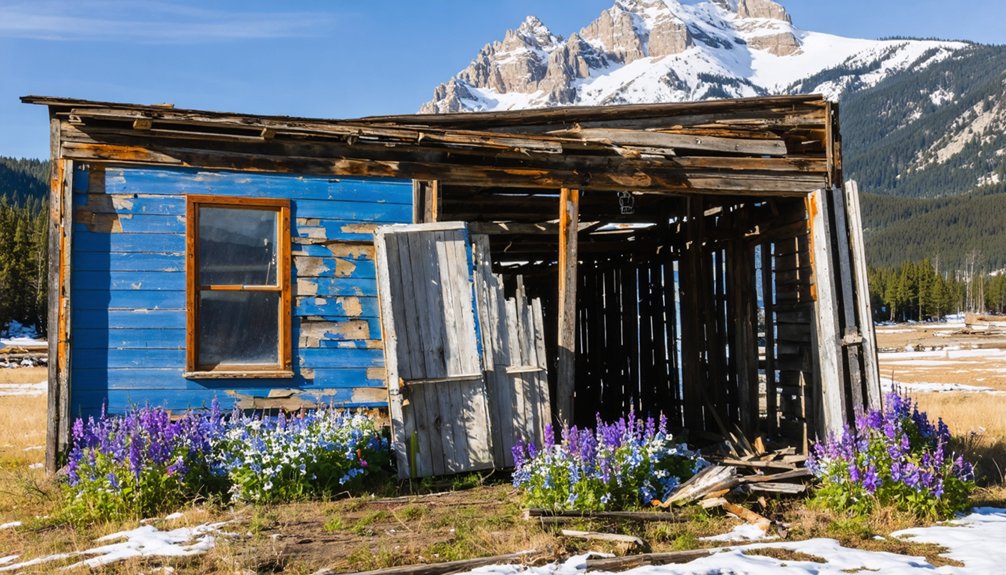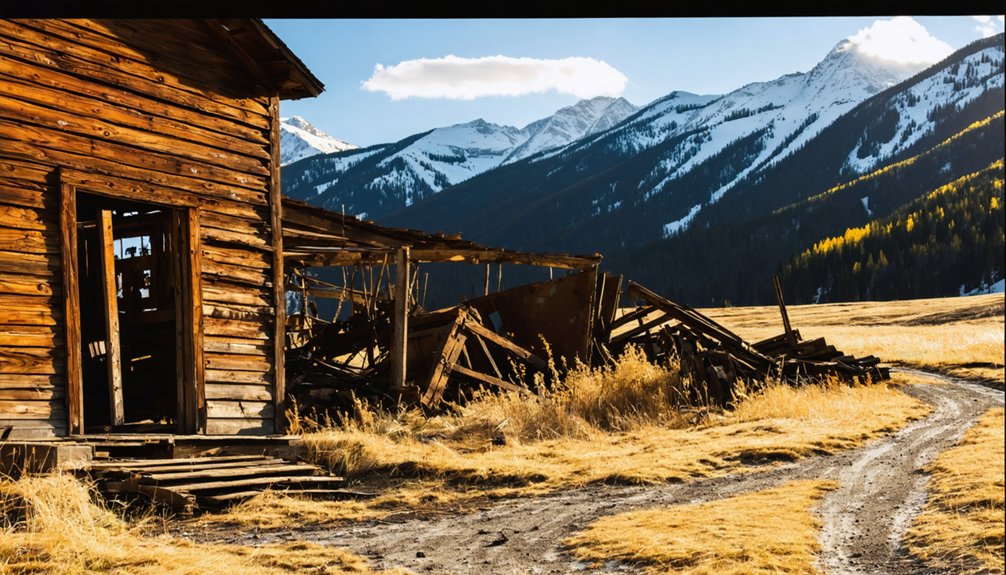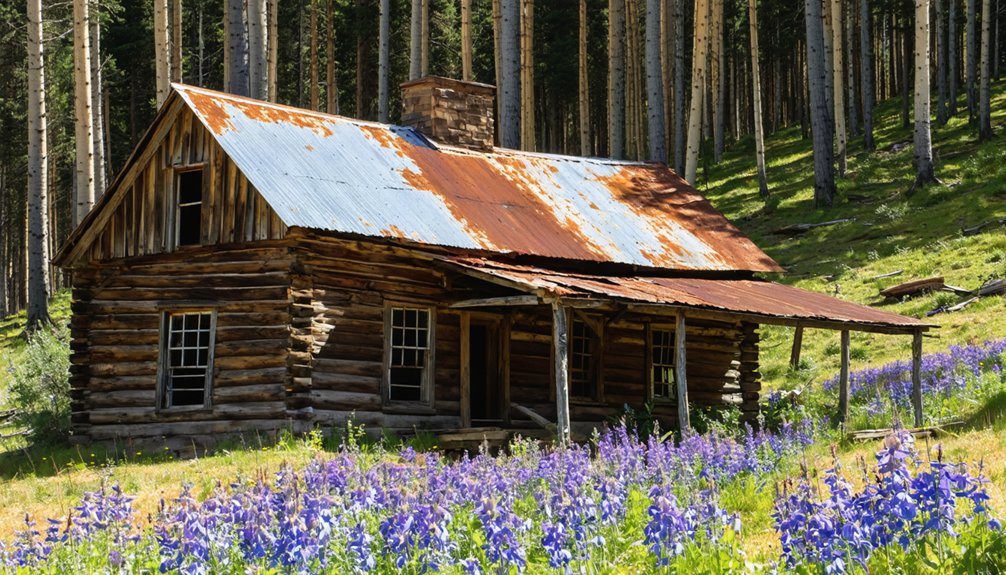Robinson was a thriving silver mining settlement in Colorado’s San Juan Mountains that rose to prominence in the 1880s. You’ll find its remains at 9,800 feet elevation, where hardy miners once extracted $4.7 million in silver before the crash of 1893 decimated the economy. Canvas tents evolved into a community with twelve saloons and a bookstore before tailings burial in 1926 entombed portions of this once-bustling hub. The weathered structures tell compelling tales of frontier resilience.
Key Takeaways
- Originally named Robinson before becoming Ironton in 1883, this mining settlement thrived during Colorado’s silver boom era.
- Located at 9,800 feet elevation, the town peaked around 1890 with approximately 320 residents.
- The 1893 federal demonetization of silver devastated Robinson’s economy, reducing population from hundreds to dozens by 1910.
- Part of the Red Mountain Mining District which produced over $30 million in minerals during the 1880s.
- Environmental legacy includes toxic runoff and weathered structures that remain as historical artifacts of America’s mining frontier.
The Discovery of a Silver Boomtown
As the summer sun beat down on the rugged San Juan Mountains in 1881, four determined prospectors—John Robinson, A. Meldrum, A.E. Long, and A. Deitlaf—staked their first claim, the Guston Mine.
Initially, they deemed the surface ore unworthy of market shipment, but freedom from poverty awaited just beneath the surface.
The true breakthrough came in August 1882 when Robinson discovered a massive chunk of lead and silver ore just 300 yards from their original claim.
This silver discovery transformed their fortunes. Within weeks, they extracted 4,500 pounds of ore yielding an astounding 88 ounces of silver per ton.
Robinson quickly established additional mining claims—the Robinson, Yankee Girl, and Orphan Boy—marking the birth of a boomtown that would soon echo with the sounds of prosperity. The innovative miners created interconnected tunnels between their claims to facilitate ore extraction and transportation.
Like Georgetown’s historic silver boom that began in 1866, Robinson’s discovery triggered a rapid influx of miners and investors seeking fortune in the mountains.
Life at 9,800 Feet: Early Days in Robinson
You’d have withstood brutal nights in canvas tents before proper log cabins appeared, your only warmth coming from primitive stoves fighting against the thin mountain air.
Robinson’s social contrasts emerged quickly as rough-hewn saloons stood alongside surprisingly sophisticated bookstores, creating unlikely cultural outposts at nearly two miles above sea level.
Your daily existence revolved around the unforgiving rhythm of the mines, where you’d descend into the earth each morning and emerge exhausted each evening, your lungs filled with dust and your pockets hopefully heavier with silver earnings. Similar to Antoine Janis who described the Cache la Poudre Valley as beautiful with high streams and abundant wildlife, Robinson settlers found both harsh conditions and natural splendor in their mountain surroundings. Despite the challenging environment, the population growth continued steadily throughout the early 1830s, mirroring the expansion seen in other colonial settlements of the period.
Brutal Tent Living
While most mining settlements endured hardships, Robinson’s elevation of 9,800 feet created uniquely brutal living conditions for its early inhabitants.
Over 1,000 men crowded into this glacial cirque by late 1883, most living in flimsy tent accommodations despite the punishing mountain environment.
Imagine your daily survival strategies when:
- Sulphuric acid in the water supply corroded your metal cookware and tools
- Avalanches threatened to sweep away your canvas shelter during heavy snowfall periods
- Winter isolation cut off supply routes for weeks, leaving you dependent on whatever provisions you’d stockpiled
You’d have watched the gradual construction of permanent structures with envy, knowing your tent offered little protection from the biting winds and temperatures that could plummet without warning.
The promise of mineral wealth kept you there, enduring conditions that would break lesser spirits.
Many residents hoped their suffering would pay off like it did in nearby mining towns that struck silver and established thriving communities before the devaluation of 1893.
Like in Animas Forks, the residents faced the constant threat of devastating avalanches that could wipe out entire sections of the settlement in minutes.
Saloons and Bookstores
Despite the harsh mountain environment that tested even the heartiest souls, Robinson’s social landscape flourished with remarkable speed. By late 1883, you’d find yourself choosing between twelve different saloons after your shift in the mines.
This robust saloons culture became the heartbeat of the community, where over a thousand men gathered to escape the isolation of mountain life. The settlement was officially renamed Ironton by April 1883, though locals continued using both names interchangeably for years.
What distinguished Robinson from typical mining camps was its surprising cultural depth. The presence of a bookstore signified more than mere commerce—its bookstore significance revealed aspirations beyond temporary extraction.
While you might still sleep in a tent despite the hundred-plus structures dotting the landscape, you could nourish both body and mind at four different restaurants and browse literary works at 9,800 feet above sea level. The town reached its peak around 1890 with a population of about 320 residents, primarily supporting the thriving mining operations and wagon traffic through the region.
Daily Mining Hardships
Life at Robinson’s extraordinary elevation of 9,800 feet presented challenges that transformed routine mining tasks into feats of endurance. You’d have battled the thin mountain air while swinging picks for hours, your body demanding oxygen that simply wasn’t available.
Mining innovations like the Joker Tunnel eventually improved conditions, but not before countless men sacrificed their health to sulfuric acid vapors and metal exposure. Unlike Robinson, the ghost town of Independence is situated 16 miles east of Aspen on Highway 82, offering visitors a glimpse into similar mining-era struggles. These abandoned settlements are part of Colorado’s ghost town heritage that includes nearly 150 documented locations throughout the state.
Community resilience emerged through shared hardship:
- The corrosive sulfide ores destroyed equipment within months, requiring constant vigilance and repairs.
- Winters trapped you between October and May, when food shortages threatened survival.
- Your simple tent or wooden shelter offered minimal protection against mountain storms that could strike without warning.
These weren’t just occupational hazards—they were daily battles against nature itself.
From Copper Glen to Mining Hub
You’d scarcely recognize the fledgling settlement of Copper Glen after it transformed into the bustling hub of Ironton by April 1883, with over 1,000 miners pouring in and erecting more than 100 structures.
The town’s rapid expansion, fueled by the timely arrival of the Denver & Rio Grande Railway in nearby Silverton, created a social ecosystem where twelve saloons coexisted with a single bookstore.
This transportation junction quickly became the commercial heart of the Red Mountain Mining District, serving as a vital stage and supply center for operations at the Yankee Girl, Orphan Boy, and other promising claims throughout Tenmile Canyon.
Railroad Fuels Rapid Growth
When the Silverton Railroad reached completion in 1889, Robinson’s transformation from modest copper claim to thriving mining center accelerated at an unprecedented pace.
The railroad expansion connected Robinson to Silverton and neighboring mining towns along Red Mountain Pass, dramatically reducing shipping costs and boosting mining profitability for operations like the legendary Yankee Girl Mine.
You’d have witnessed three remarkable changes to the landscape:
- The construction of Robinson’s depot—the only one on Red Mountain
- Population swelling to nearly 850 residents as prosperity spread
- The emergence of hotels, stores, and milling operations where once stood empty mountainside
The Joker Tunnel, begun in 1904, exemplified the technological ambition railroad access enabled.
This engineering marvel extended nearly a mile underground, allowing miners to penetrate 600 feet deeper into the mountain’s rich veins.
Twelve Saloons, One Bookstore
Though originally established as Copper Glen in January 1883, the settlement quickly outgrew its modest beginnings to become a vibrant mining community perched at 9,800 feet elevation in the Red Mountain Mining District.
By year’s end, over 1,000 men called this boom town home, with more than 100 structures dotting the landscape.
The saloons culture dominated Ironton’s social scene, with twelve establishments serving thirsty miners after grueling shifts.
You’d find men crowded around tables, sharing tales of the day’s discoveries at the Yankee Girl or Orphan Boy claims.
Yet amid this rugged environment, a touch of refinement existed—a single bookstore stood as evidence to the settlement’s intellectual aspirations.
This bookstore significance shouldn’t be underestimated, offering miners mental escape from the harsh realities of mountain life and equipment that deteriorated in months from sulfuric acid exposure.
Tenmile Canyon Mining Boom
As prospectors scoured the high country in search of fortune during the late 1850s, they stumbled upon placer gold near what would become Breckenridge, igniting a feverish rush to the Tenmile District.
You can trace the rise of Robinson from those primitive mining camps to a bustling hub after the pivotal 1878 silver discovery transformed the canyon’s destiny.
Three factors that fueled Robinson’s explosive growth:
- Development of advanced mining techniques that could process complex silver-lead ores
- Strategic location just a mile from Kokomo with proximity to rich mineral veins
- Establishment of critical infrastructure including smelting works and transportation
The Railroad’s Arrival and Economic Impact
The arrival of the Denver & Rio Grande Railway in nearby Silverton during 1882 forever altered Robinson’s economic trajectory, coinciding fortuitously with major silver ore discoveries throughout the Red Mountain district.
You’d scarcely recognize the transformation that followed. Otto Mears’ completion of the Silverton-Ouray toll road in 1884 established Robinson as an essential transportation hub, but it was the narrow gauge Silverton Railroad‘s 1889 arrival that truly revolutionized the region’s economic potential.
With dramatically reduced shipping costs, mines became substantially more profitable. The railroad’s impact manifested in Robinson’s population surge to 323 residents by 1890, with trains running twice daily at peak operations.
Despite winter closures between January and May, this railroad history catalyzed an unprecedented economic transformation that investors believed would sustain growth indefinitely—until silver’s demonetization in 1893 changed everything.
Daily Life in a Rocky Mountain Mining Town

Life in Robinson unfolded amid stark contrasts of hardship and camaraderie that defined Rocky Mountain mining settlements of the era.
You’d have found yourself living in tightly packed cabins with windows made of flattened tin rather than glass, your dwelling elbowing against your neighbor’s in a physical manifestation of community resilience.
Your daily existence revolved around three essential rhythms:
- Grueling 12-hour underground shifts lit only by oil lamps strapped to your head
- Evenings spent in saloons and boarding houses where miner camaraderie flourished despite exhaustion
- Meals centered around bacon, beans, and eventually local game that sustained your labor-worn body
While churches and newspapers attempted to impose order, you’d have found freedom in this rugged social fabric woven from shared hardship and mutual dependence.
The Challenge of Sulfide Ores
While miners struggled with the daily hardships of Rocky Mountain life, beneath their boots lay an even greater challenge: sulfide ores that would both plague and ultimately sustain Robinson’s economy.
These complex mineral deposits, yielding impressive silver values of 600 to 1,400 ounces per ton, defied early extraction methods with their irregular formations and zinc content.
Beneath Robinson’s rugged terrain hid silver-rich deposits that mocked traditional mining—nature’s puzzle of wealth and frustration.
You’d have witnessed a remarkable transformation in 1905, when revolutionary sulfide processing techniques arrived.
Roasters and magnetic separators converted what was once considered worthless into valuable commodities.
Mining technologies evolved precisely when Robinson needed them most, allowing the Eagle Mine to become Colorado’s leading silver producer by 1930.
The once-problematic zinc became a prized asset, with the total value of sulfide production reaching an astounding $4.7 million between 1881 and 1896.
The Silver Crash and Robinson’s Struggle

When the federal government demonetized silver in 1893, Robinson’s prosperity shattered almost overnight, delivering a devastating blow to the town’s economic foundation.
As silver prices plummeted, you’d have witnessed the rapid exodus of miners seeking work elsewhere, while mining investments dried up completely. The once-bustling community withered as the railroad scaled back operations, further isolating Robinson from crucial markets.
The crash’s brutal effects manifested in three distinct ways:
- Population collapse from hundreds to mere dozens by 1910
- Abandonment of critical infrastructure projects, including the planned electric railroad
- Widespread closure of mines, businesses, and essential services
The spirit of this once-proud mining town dimmed as the economic stranglehold tightened, forcing its rugged inhabitants to abandon their mountain home in search of new beginnings.
Last Decades of a Fading Town
The harsh reality of Robinson’s post-crash existence became painfully evident in the early 1900s, as the town’s heartbeat slowed to a barely perceptible rhythm.
The mining town’s pulse faded to whispers, its once-vibrant streets surrendering to mountain silence.
You’d have witnessed the final exodus as urban migration emptied homes and shuttered businesses. At 10,000 feet elevation, the harsh winters drove away all but the most resilient souls, while sulfide ore corroded mining equipment and diminished profitability.
Community memories faded as the post office closed, railroad service ended, and the last saloons went quiet.
The Joker Tunnel project briefly extended mining operations, but couldn’t reverse the inevitable decline.
What Remains: Robinson’s Physical Legacy

If you visit Robinson today, you’ll find the haunting remnants of cabins from the 1870s alongside visible foundations that trace the town’s once-planned layout.
Mining equipment and tailings deposits still mark the cliffs above canyons, silent witnesses to the challenging engineering feats accomplished by early prospectors.
These industrial remains also represent Robinson’s toxic legacy, as the 1926 tailings burial entombed portions of the town and left environmental scars that persist nearly a century later.
Structural Ruins Today
Numerous weathered structures stand as silent sentinels to Robinson’s once-thriving mining community, each decaying timber and crumbling foundation telling stories of Colorado’s boom-and-bust heritage.
You’ll find wood-framed houses and elongated communal cabins showcasing architectural features that have withstood harsh mountain winters despite minimal preservation efforts.
As you explore the ghost town, you’ll discover:
- Stone foundations and chimney bases marking what was once a bustling Main Street
- Smaller outbuildings including smokehouses and storage structures that reveal daily frontier life
- Visible wagon trails and stagecoach paths that once connected this remote settlement to civilization
These structural footprints, now embraced by the wilderness, offer you freedom to wander among authentic remnants of frontier ingenuity, untouched by modern restoration.
Mining Equipment Remnants
Beyond the weathered dwellings and deteriorating storefronts, Robinson’s industrial backbone emerges through scattered mining equipment that once powered this frontier economy.
As you explore, you’ll discover concrete foundations where massive machinery once stood, silent testimonies to the town’s industrial might.
Look closely and you’ll spot electrical infrastructure remnants—insulators and cable hangers that brought power to the depths below. These technological innovations transformed Robinson’s mining potential, enabling deeper extraction and increased production.
Scattered mining tools, drill bits, and machinery fragments tell stories of daily labor, while ore bins and loading chutes reveal how precious minerals traveled from underground chambers to market.
The hoisting equipment remnants remind you that men descended hundreds of feet below, where diamond drills bit into mountain rock, feeding the town’s brief prosperity.
Toxic Environmental Impact
While Robinson’s crumbling structures evoke nostalgic visions of frontier prosperity, the town’s most enduring legacy lies beneath your feet in a toxic environmental footprint that continues to shape the landscape today.
This invisible heritage reveals itself through the landscape’s scars, where spring snowmelt washes heavy metals through abandoned mine dumps.
Three lasting environmental impacts you’ll witness:
- Streams discolored by toxic runoff carrying contaminants from disturbed mining areas
- Altered topography that remains visibly distinct from surrounding natural landscapes
- Engineered barriers and treatment systems standing as modern monuments to contain yesterday’s pollution
The BLM’s ongoing monitoring and remediation efforts represent mankind’s attempt to reconcile with the environmental costs of resource extraction—a sobering reminder of prosperity’s true price.
The Red Mountain Mining District’s Historical Significance

Nestled within Colorado’s rugged San Juan Mountains, the Red Mountain Mining District emerged as one of the state’s most significant mineral treasure troves during the 1880s mining boom.
Second only to Leadville in production value, this district yielded over $30 million in precious metals—equivalent to a quarter billion in today’s economy.
When you explore this historic landscape, you’ll witness remnants of innovative mining techniques that evolved from simple ore extraction to sophisticated tunnel systems.
The district’s economic fluctuations mirror America’s industrial journey, from the silver rush excitement of the 1880s through consolidation under Idarado Mining Company by 1939.
The iconic Yankee Girl Mine headframe still stands as evidence of an era when nearly 3,000 residents built their lives around these hills, pursuing wealth and independence in Colorado’s mineral-rich mountains.
Frequently Asked Questions
Are There Any Paranormal or Ghost Stories Associated With Robinson?
Unlike 60% of Colorado’s ghost towns, Robinson hasn’t yielded documented ghost sightings or local legends. You’ll find its abandoned buildings evoke nostalgic mystery without the supernatural narratives that define other mining settlements.
Can Visitors Legally Explore or Collect Artifacts From Robinson Today?
No, you cannot legally explore Robinson without written permission from the landowner. Artifact preservation laws strictly prohibit collection, with penalties for violations. Visitor regulations protect this private historical treasure.
What Happened to the Wealth Generated During Robinson’s Mining Boom?
You’ll find mining profits flowed primarily to wealthy investors, not individual miners. Local wealth distribution briefly sparked infrastructure development but wasn’t sustained, as most riches drained away to outside interests, leaving little permanent prosperity.
Did Any Famous Historical Figures Visit or Live in Robinson?
While you’d relish tales of Wild Bill Hickok stopping by, historical records don’t document any famous visitors to Robinson. The town’s historical significance remains tied to its mining operations, not celebrity connections.
How Did Robinson’s Miners Handle Medical Emergencies in Such Isolation?
You’d rely on your fellow miners for first aid, with basic skills passed among you. Your emergency plans involved community networks and perilous journeys to distant towns when absolutely necessary.
References
- https://www.historynet.com/ghost-town-ironton-colorado/
- https://www.coloradolifemagazine.com/printpage/post/index/id/172
- https://aspenhistory.org/independence-ghost-town/
- https://en.wikipedia.org/wiki/List_of_ghost_towns_in_Colorado
- https://www.colorado.com/articles/colorado-ghost-towns
- https://digital.denverlibrary.org/nodes/view/1023487
- https://www.youtube.com/watch?v=iQin09ptJfk
- https://ghosttownclub.org/about/
- https://www.legendsofamerica.com/guston-colorado/
- https://lakeviewflats.com/silver-boom-and-beyond-the-rich-mining-history-of-georgetown-colorado/



